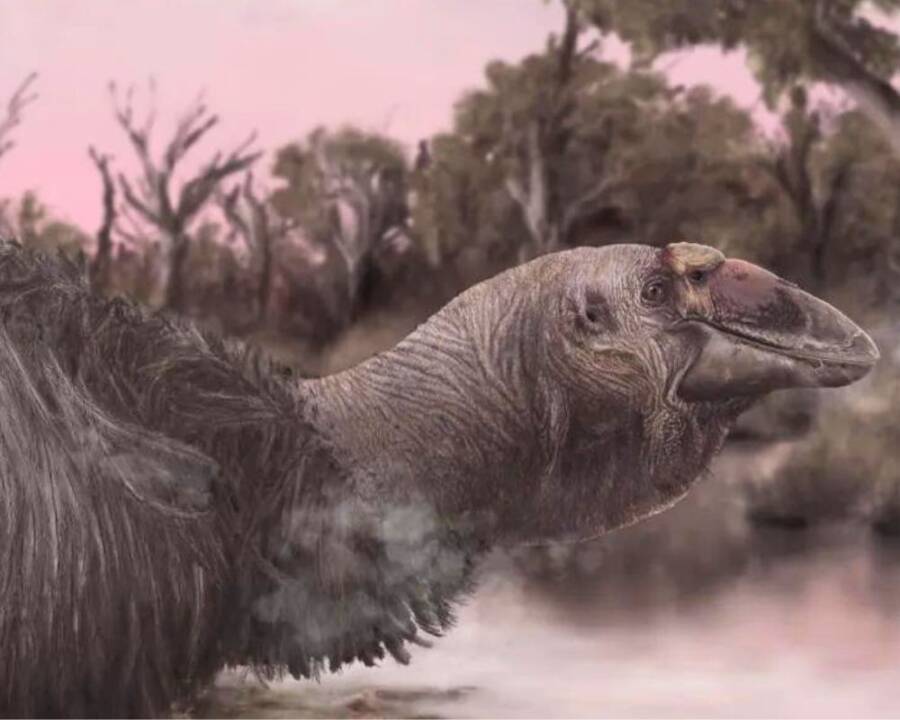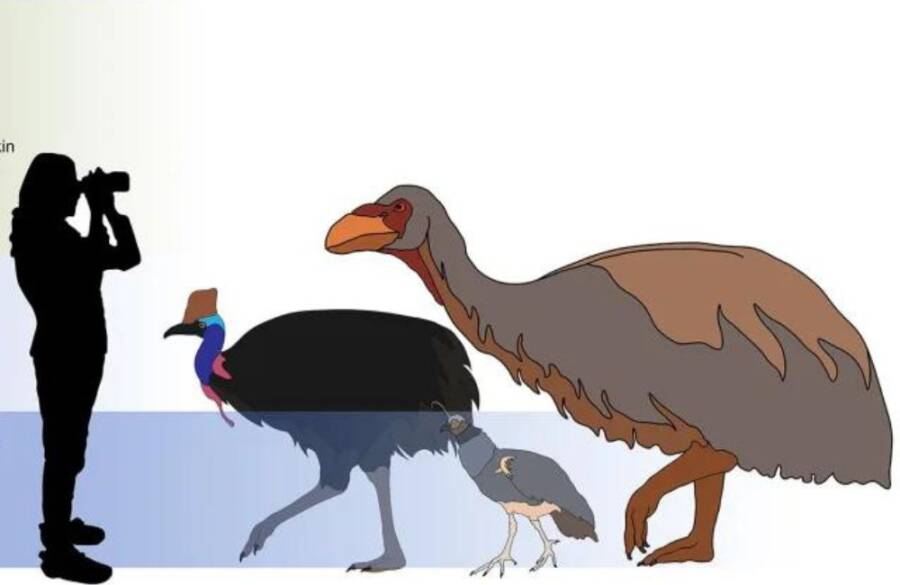Genyornis newtoni was six feet tall, weighed up to 500 pounds, and used its goose-like beak to eat aquatic plants 45,000 years ago.

Jacob C. Blokland/Flinders UniversityAn artistic rendition of Genyornis newtoni, the “giga-goose” of prehistoric Australia.
For more than a century, researchers have struggled to find a complete skeleton of Genyornis newtoni, a prehistoric flightless bird that roamed the wilds of Australia more than 45,000 years ago.
Then, in 2019, paleontologists from the Flinders University unearthed a well-preserved skull from this extinct creature that allowed them to determine what it would have looked like. For years, researchers assumed that G. newtoni was a prehistoric emu — but this latest discovery reveals that it was more akin to a “giant goose.”
Discovering The Fossilized Skull Of ‘Genyornis Newtoni’
Since the late 19th century, researchers have uncovered a handful of fossils from the Dromornithidae clade, the family of flightless birds to which G. newtoni belongs.
The only other fossilized remains of G. newtoni were unearthed in 1913, but they were heavily damaged. Because of this, the size and morphology of the creature’s skull have remained a mystery until very recently.

Flinders UniversityThe fossilized skull of Genyornis newtoni.
In 2019, a team of researchers from Flinders University discovered the most complete skull of G. newtoni ever found while carrying out excavations in South Australia’s Lake Callabonna Fossil Reserve. Now, the paleontologists have published their findings in the journal Historical Biology.
Analysis of the fossilized remains revealed that the prehistoric creature was strikingly similar to one modern bird. As Phoebe McInerney, an evolutionary biologist at Flinders University and a lead author of the study, put it, “[W]ith this new skull we have started to piece together the puzzle which shows, simply put, this species to be a giant goose.”
What Did The ‘Giga-Goose’ Look Like?
“There’s no close analogue for these birds” Nic Rawlence, a paleoecologist at the University of Otago in New Zealand, told Scientific American. “They are a truly unique Australian island experiment, as unique as koalas and kangaroos. With this amazing new discovery, we can now actually start to reconstruct the evolution and the behavior of this animal.”
According to researchers, G. newtoni was more than six feet tall and weighed up to 500 pounds. Its beak was long and similar to that of a modern goose.

Phoebe McInerney/Flinders UniversityA size comparison of G. newtoni to a human and other modern birds like the cassowary and the horned screamer.
“The beak itself is very goose-like, so we have this wide, flat, rounded end,” said McInerney. Researchers believe a small bump near the top of the beak may have been used to attract mates.
The beak shape suggests that G. newtoni primarily ate soft leaves and fruit and even ventured into the water to dine on aquatic plants. Despite not having a duckbill or webbed feet, G.newtoni was likely very adept at feeding in the water.
“They also interestingly have features that allow them to open and close their jaw underwater… without impacting their hearing or [water] going up into their palate or nose, which is quite unusual because we weren’t expecting to see these water-based adaptions in the skull,” McInerney stated.
Researchers believe a combination of climate change and hunting led to the extinction of these “giga-geese” around 45,000 years ago. At that time, freshwater lakes in Australia began drying up. And early humans likely used the eggs of G. newtoni as a food source.
These two factors together brought about the downfall of G. newtoni, the giant flightless bird of prehistoric Australia.
After reading about this giant, prehistoric goose, dive into the true story of the Glyptodon, the prehistoric armadillo that measured 10 feet in length and weighed a ton. Then, learn about the fearsome Megalodon, the largest shark in world history.





